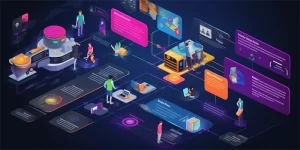The era of striving to capture the perfect selfie is slowly fading away. Thanks to advancements in Artificial Intelligence (AI), we now have the ability to create flawless digital representations of ourselves called AI Avatars. These avatars not only eliminate the need for constant photo retakes but also provide a whole new level of personalization and expression. Let’s delve into how AI Avatars are revolutionizing the way we present ourselves in the digital realm.

1. Lifelike Replicas with AI Technology
AI Avatars utilize state-of-the-art machine learning algorithms to analyze facial features, expressions, and body language. This enables them to create highly accurate and lifelike replicas of individuals. Unlike traditional selfies, where lighting and angles can distort our appearance, AI Avatars provide a true representation of ourselves.
Furthermore, AI Avatars can be customized to reflect our desired characteristics, enabling us to project the image we want to convey. Whether it’s a polished professional look or a more casual and quirky representation, AI Avatars allow us to curate our digital identity effortlessly.
2. Endless Customization Options
AI Avatars offer a vast array of customization options. From choosing facial features, hairstyles, and clothing styles to adjusting body proportions and skin tones, the possibilities are virtually endless. This level of customization allows us to create the ideal version of ourselves and express our individuality in the digital world.
Moreover, AI Avatars offer accessibility options for individuals with disabilities. People with mobility issues or speech impairments can create avatars that accurately represent their physical appearance and convey their unique personality, thereby fostering inclusivity and representation in the virtual realm.
3. Enhanced Creativity and Expression
With AI Avatars, the limitations of traditional selfies no longer hinder our ability to express ourselves creatively. We can experiment with different looks, styles, and even fantastical elements that would otherwise be impossible to capture in a regular photograph. AI Avatars empower us to push the boundaries of self-expression and showcase our creativity to the world.
Additionally, AI Avatars can dynamically adapt to reflect our emotions in real-time. They respond to changes in facial expressions and body language, allowing us to convey complex emotions accurately. This opens up new possibilities for communication and expression in the realm of virtual interactions.
4. Privacy and Security
AI Avatars provide a layer of privacy and security that is often lacking in traditional selfies. By using avatars instead of actual photographs, we can ensure that our personal information and appearance are protected from potential misuse. This is particularly relevant in an age where privacy concerns are paramount.
Furthermore, AI Avatars allow us to share our digital representations without the fear of manipulation or unauthorized use. The encryption and authentication measures in place ensure that our avatars remain within our control, mitigating risks of identity theft and counterfeit accounts.
5. Adoption in Virtual Reality and Gaming
The gaming and virtual reality industries have embraced AI Avatars with open arms. Avatars created using AI technology can seamlessly blend with virtual environments, providing a more immersive and personalized experience for users. From gaming avatars that mimic our real-life movements to virtual reality social platforms that enable us to interact as avatars, the possibilities for engagement are boundless.
Additionally, AI Avatars open up opportunities for cross-platform interactions. We can use our customized avatars in various virtual environments, providing a consistent digital representation across different applications and platforms.
6. Integration in Video Conferencing and Remote Work
In the wake of the COVID-19 pandemic, remote work and video conferencing have become the new norm. AI Avatars offer a solution to the challenges of video conferences, ensuring a professional and polished appearance even in less-than-ideal circumstances. With AI Avatars, we can project a put-together image, eliminating distractions caused by messy backgrounds or personal insecurities.
Furthermore, AI Avatars enable us to maintain a sense of privacy during video conferences. Individuals who are uncomfortable sharing their actual appearance on camera can use AI Avatars to participate confidently, fostering inclusivity and reducing potential biases related to physical appearances.
7. Overcoming Cultural Barriers and Biases
AI Avatars have the potential to transcend cultural barriers and biases, promoting inclusivity and understanding. By representing ourselves through avatars, we can focus on shared ideas, knowledge, and expertise instead of being judged based on external factors such as race, gender, or physical appearance.
This technology has profound implications for industries that heavily rely on visuals, such as modeling and casting. AI Avatars can assist in breaking down ingrained biases, allowing talent and creativity to shine brightest, irrespective of societal norms or stereotypes.
8. FAQs
Q: How can AI Avatars be used in social media platforms?
A: AI Avatars can be integrated into social media platforms, enabling users to communicate and interact using their digital representations. This amplifies personalization and creativity in social media activities.
Q: Can AI Avatars be used for nefarious purposes, such as identity theft?
A: While there is always a risk of misuse in any technology, AI Avatars have robust security measures in place to protect against identity theft. Encryption, biometric authentication, and user-centric control mechanisms ensure the safety and authenticity of AI Avatars.
Q: Are AI Avatars accessible for people with disabilities?
A: Yes, AI Avatars offer accessibility options for people with disabilities. Individuals with mobility or speech impairments can create avatars that accurately represent them, promoting inclusivity and representation in the digital world.
Conclusion
The advent of AI Avatars marks a new era where we no longer need to chase the perfect selfie. These digital representations provide lifelike replicas, endless customization options, enhanced creativity, and improved privacy and security. With their integration in various industries and applications, AI Avatars are revolutionizing our digital presence and transforming the way we interact and express ourselves in the virtual realm.
References
(If no references, delete this section)








